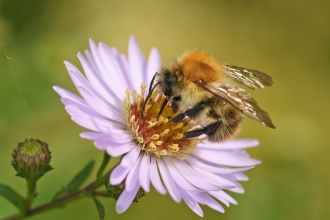
Red-tailed bumblebee on bird's foot trefoil by Jon Hawkins - Surrey Hills Photography
Different kinds of bees
We're all familiar with the sound of masses of buzzing bees on a warm summer's day. But did you know that these bees can be many different species?
There are several hundred different types of bee resident in the British Isles. We talk about two different groups: social bees and solitary bees.
Other insects like hoverflies, hornet moths and clearwing moths, mimic the colours of bees so they don't get eaten.
Social bees
As their name suggests, social bees live in groups. Honeybees are particularly sociable and can live in groups of up to 50,000 together in a single hive. Bumblebees are also social, but live in smaller groups of 50-150. Both types depend on queen bees who lay all of the eggs for the group.
Social bees are a common sight in our gardens. You might see (click on the picture for more information):
Solitary bees
In contrast, solitary bees live on their own. They can make burrows underground, or live in quarry faces, old wood, and even masonry. A female solitary bee builds her nest and provides food for her young without the help of any worker bees. Despite this some solitary bees may appear to live in colonies, with many bees making their nests close to each other in a suitable piece of habitat.
There are over 250 kinds of solitary bee. Here are a few you might see (click on the picture for more information):
Help bees at home
Find actions you can take to help bees and other wildlife at home

The best plants for bees and pollinators
Set up a ‘nectar café’ by planting flowers for pollinating insects like bees and butterflies

How to make a bee hotel
Solitary bees are important pollinators and a gardener’s friend. Help them by building a bee hotel for your home or garden and watch…

How to make a seed bomb
Plant wildflower with seed bombs!











